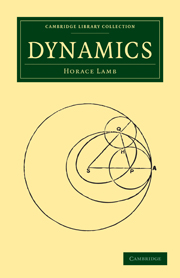Book contents
- Frontmatter
- PREFACE
- Contents
- CHAPTER I KINEMATICS OF RECTILINEAR MOTION
- CHAPTER II DYNAMICS OF RECTILINEAR MOTION
- CHAPTER III TWO-DIMENSIONAL KINEMATICS
- CHAPTER IV DYNAMICS OF A PARTICLE IN TWO DIMENSIONS. CARTESIAN COORDINATES
- CHAPTER V TANGENTIAL AND NORMAL ACCELERATIONS. CONSTRAINED MOTION
- CHAPTER VI MOTION OF A PAIR OF PARTICLES
- CHAPTER VII DYNAMICS OF A SYSTEM OF PARTICLES
- CHAPTER VIII DYNAMICS OF RIGID BODIES. ROTATION ABOUT A FIXED AXIS
- CHAPTER IX DYNAMICS OF RIGID BODIES (CONTINUED). MOTION IN TWO DIMENSIONS
- CHAPTER X LAW OF GRAVITATION
- CHAPTER XI CENTRAL FORCES
- CHAPTER XII DISSIPATIVE FORCES
- CHAPTER XIII SYSTEMS OF TWO DEGRESS OF FREEDOM
- APPENDIX. NOTE ON DYNAMICAL PRINCIPLES
- INDEX
CHAPTER VII - DYNAMICS OF A SYSTEM OF PARTICLES
Published online by Cambridge University Press: 07 September 2010
- Frontmatter
- PREFACE
- Contents
- CHAPTER I KINEMATICS OF RECTILINEAR MOTION
- CHAPTER II DYNAMICS OF RECTILINEAR MOTION
- CHAPTER III TWO-DIMENSIONAL KINEMATICS
- CHAPTER IV DYNAMICS OF A PARTICLE IN TWO DIMENSIONS. CARTESIAN COORDINATES
- CHAPTER V TANGENTIAL AND NORMAL ACCELERATIONS. CONSTRAINED MOTION
- CHAPTER VI MOTION OF A PAIR OF PARTICLES
- CHAPTER VII DYNAMICS OF A SYSTEM OF PARTICLES
- CHAPTER VIII DYNAMICS OF RIGID BODIES. ROTATION ABOUT A FIXED AXIS
- CHAPTER IX DYNAMICS OF RIGID BODIES (CONTINUED). MOTION IN TWO DIMENSIONS
- CHAPTER X LAW OF GRAVITATION
- CHAPTER XI CENTRAL FORCES
- CHAPTER XII DISSIPATIVE FORCES
- CHAPTER XIII SYSTEMS OF TWO DEGRESS OF FREEDOM
- APPENDIX. NOTE ON DYNAMICAL PRINCIPLES
- INDEX
Summary
Linear and Angular Momentum.
When we have to deal with a system of isolated particles we may begin as in Art. 40 by forming the equations of motion of each particle separately, taking account, of course, of the mutual actions, as well as of the forces acting on the system from without. In these equations each component of internal force will appear twice over, with opposite signs, viz. in the equations of motion of the two particles between which the force in question acts.
If the system is subject to frictionless constraints, a geometrical relation is in each case supplied, which contributes to determine the unknown reaction involved in the constraint. Thus if one of the particles is restricted to lie on a smooth surface, we have the equation of the surface.
The complete solution of such problems is, as may be expected, usually difficult. For instance, the fundamental problem of Physical Astronomy, viz. the ‘problem of three bodies,’ which is to determine the motions of three mutually gravitating particles (e.g. the sun, the earth, and the moon), can only be solved by elaborate methods of approximation.
There are, however, two general results which hold whatever the nature of the mutual actions in the system. Before proceeding to these it is convenient to premise one or two kinematical theorems which will simplify the statements.
The momenta of the several particles of the system evidently constitute a series of localized vectors [S. 18] which, for the purposes of resolving and taking moments, may be treated by the same rules as forces in Statics.
- Type
- Chapter
- Information
- Dynamics , pp. 137 - 149Publisher: Cambridge University PressPrint publication year: 2009First published in: 1923



